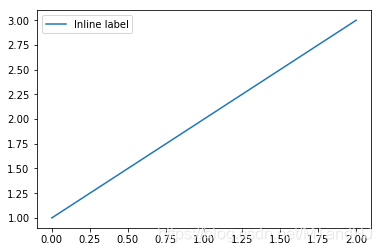matplotlib 进阶之Legend guide
import numpy as np
import matplotlib.pyplot as plt
matplotlib.pyplot.legend
在开始教程之前,我们必须先了解matplotlib.pyplot.legend(),该函数可以用以添加图例。
方法1自动检测
通过这种方式,lendgend()会从artist中获取label属性,并自动生成图例,比如:
fig, ax = plt.subplots()
line, = ax.plot([1, 2, 3], label="Inline label")
ax.legend()
plt.show()
或者:
line.set_label("Inline label")
ax.legend()

方法2为现有的Artist添加
我们也可以通过下列操作,为已经存在的Artist添加图例,但是这种方式并不推荐,因为我们很容易混淆。
fig, ax = plt.subplots()
line, = ax.plot([1, 2, 3])
ax.legend(["A simple line"])

方3显示添加图例
我们也可以显示添加图例:
fig, ax = plt.subplots()
line1, = ax.plot([1, 2, 3])
line2, = ax.plot([3, 2, 1])
ax.legend((line1, line2), ("line1", "line2"))

参数:
handle: Artist
label: 标签
loc:位置,比如"best":0, "upper right" 1 ...
fontsize
...
控制图例的输入
直接使用legend()命令,matplotlib会自动检测并生成图例,这种方式等价于:
handles, labels = ax.get_legend_handles_labels()
ax.legend(handles, labels)
需要注意的是,只有为Artist设置标签了,通过get_legend_handles_labels()才有效。
有些时候,我们只需要为部分Artist设置图例,这时只需手动传入handles:
line_up, = plt.plot([1,2,3], label='Line 2')
line_down, = plt.plot([3,2,1], label='Line 1')
plt.legend(handles=[line_up, line_down])
当然了,相应的可以传入标签:
line_up, = plt.plot([1,2,3], label='Line 2')
line_down, = plt.plot([3,2,1], label='Line 1')
plt.legend([line_up, line_down], ['Line Up', 'Line Down'])
为一类Artist设置图例
并不是所有的Artist都能被自动设置为图例,也不是所有Artist都需要被设置为图例。
假如我们想要为所有红颜色的玩意儿设置图例:
import matplotlib.patches as mpatches
x = np.arange(1, 4)
fig, ax = plt.subplots()
for i in range(1, 10):
ax.plot(x, i * x, color = "red" if i % 2 else "blue")
red_patch = mpatches.Patch(color="red")
# red_patch: <matplotlib.patches.Patch object at 0x00000228D0D4BF60>
plt.legend(handles=[red_patch], labels=["red line"])
plt.show()
如果没理解错,通过patches.Patch构造了一个颜色为红色的Artist类,然后legend()就会对所有满足条件的Artist的类进行处理(其实也用不了处理啊,只是加了图例)。错啦错啦,实际上,就是简单地造了一个颜色为红色的片,价格red line标签而已,跟已有的Artist没啥关系。

实际上,图例并不十分依赖于现有的Artist,我们完全可以随心所欲地添加:
import matplotlib.lines as mlines
blue_line = mlines.Line2D([], [], color='blue', marker='*',
markersize=15, label='Blue stars')
plt.legend(handles=[blue_line])
plt.show()

Legend 的位置 loc, bbox_to_anchor
legend()提供了loc参数,可以处理一般的位置。而bbox_to_anchor参数可以更加有效强大地来定位:
x = np.arange(1, 4)
fig, ax = plt.subplots()
for i in range(1, 10):
ax.plot(x, i * x, color = "red" if i % 2 else "blue", label="line{0}".format(i))
plt.legend(bbox_to_anchor=(1, 1),
bbox_transform=plt.gcf().transFigure)
plt.show()

bbox_to_anchor=(1,1)表示legend的位置在右上角,因为bbox_transform,我们将坐标转换为了当前figure的坐标系,也就是图例会放在整个图片的右上角,如果我们去掉这个选项:
plt.legend(bbox_to_anchor=(1, 1))

这个时候和下面是等价的:
plt.legend(bbox_to_anchor=(1,1),
bbox_transform=ax.transAxes)
即,此时的(1,1)表示的是Axes的右上角。
当我们这么做的时候:
plt.legend(bbox_to_anchor=(1, 1),
bbox_transform=ax.transData)
这个时候以数据,也就是我们看到的坐标为依据:

一个具体的例子
下面会用到的一些参数分析:
bbox_to_anchor: (x, y, width, height) 说实话,我并没有搞懂width, height的含义,有的时候能调正宽度,有的时候又不能
ncol: 图例的列数,有些时候图例太多,让他分成俩列三列啊
boderraxespad: axes与图例边界的距离。
plt.subplot(211)
plt.plot([1, 2, 3], label="test1")
plt.plot([3, 2, 1], label="test2")
# Place a legend above this subplot, expanding itself to
# fully use the given bounding box.
plt.legend(bbox_to_anchor=(0., 1.02, 1., .102), loc='lower left',
ncol=2, mode="expand", borderaxespad=0.)
plt.subplot(223)
plt.plot([1, 2, 3], label="test1")
plt.plot([3, 2, 1], label="test2")
# Place a legend to the right of this smaller subplot.
plt.legend(bbox_to_anchor=(1.05, 1), loc='upper left', borderaxespad=1.)
plt.show()

同一个Axes多个legend
如果我们多次使用legend(),实际上并不会生成多个图例:
fig, ax = plt.subplots()
line1, = ax.plot([1, 2, 3])
line2, = ax.plot([3, 2, 1])
ax.legend([line1], ["line1"])
ax.legend([line2], ["line2"])
plt.show()

为此,我们需要手动添加图例:
fig, ax = plt.subplots()
line1, = ax.plot([1, 2, 3])
line2, = ax.plot([3, 2, 1])
legend1 = ax.legend([line1], ["line1"], loc="upper right")
ax.add_artist(legend1)
ax.legend([line2], ["line2"])
plt.show()

Legend Handlers
没看懂啥意思。
from matplotlib.legend_handler import HandlerLine2D
line1, = plt.plot([3, 2, 1], marker='o', label='Line 1')
line2, = plt.plot([1, 2, 3], marker='o', label='Line 2')
plt.legend(handler_map={line1: HandlerLine2D(numpoints=4)})

from numpy.random import randn
z = randn(10)
red_dot, = plt.plot(z, "ro", markersize=15)
# Put a white cross over some of the data.
white_cross, = plt.plot(z[:5], "w+", markeredgewidth=3, markersize=15)
plt.legend([red_dot, (red_dot, white_cross)], ["Attr A", "Attr A+B"])

从这例子中感觉,就是legend_handler里面有一些现成,稀奇古怪的图例供我们使用?
from matplotlib.legend_handler import HandlerLine2D, HandlerTuple
p1, = plt.plot([1, 2.5, 3], 'r-d')
p2, = plt.plot([3, 2, 1], 'k-o')
l = plt.legend([(p1, p2)], ['Two keys'], numpoints=1,
handler_map={tuple: HandlerTuple(ndivide=None)})

自定义图例处理程序
这一节呢,主要就是告诉我们,如何通过handler_map这个参数,传入一个映射,可以构造任意?奇形怪状的图例?不过参数也忒多了吧,不过感觉蛮有用的。
import matplotlib.patches as mpatches
class AnyObject(object):
pass
class AnyObjectHandler(object):
def legend_artist(self, legend, orig_handle, fontsize, handlebox):
x0, y0 = handlebox.xdescent, handlebox.ydescent
width, height = handlebox.width, handlebox.height
patch = mpatches.Rectangle([x0, y0], width, height, facecolor='red',
edgecolor='black', hatch='xx', lw=3,
transform=handlebox.get_transform())
handlebox.add_artist(patch)
return patch
plt.legend([AnyObject()], ['My first handler'],
handler_map={AnyObject: AnyObjectHandler()})

from matplotlib.legend_handler import HandlerPatch
class HandlerEllipse(HandlerPatch):
def create_artists(self, legend, orig_handle,
xdescent, ydescent, width, height, fontsize, trans):
center = 0.5 * width - 0.5 * xdescent, 0.5 * height - 0.5 * ydescent
p = mpatches.Ellipse(xy=center, width=width + xdescent,
height=height + ydescent)
self.update_prop(p, orig_handle, legend)
p.set_transform(trans)
return [p]
c = mpatches.Circle((0.5, 0.5), 0.25, facecolor="green",
edgecolor="red", linewidth=3)
plt.gca().add_patch(c)
plt.legend([c], ["An ellipse, not a rectangle"],
handler_map={mpatches.Circle: HandlerEllipse()})

"""都是啥和啥啊。。。"""
class AnyObject(object):
pass
class AnyObjectHandler(object):
def legend_artist(self, legend, orig_handle, fontsize, handlebox):
x0, y0 = handlebox.xdescent, handlebox.ydescent
width, height = handlebox.width, handlebox.height
patch = mlines.Line2D([1, 2, 3, 4, 6], [1, 2, 3, 4, 6], linewidth=width/2, color='red',
transform=handlebox.get_transform())
handlebox.add_artist(patch)
return patch
plt.legend([AnyObject()], ['My first handler'],
handler_map={AnyObject: AnyObjectHandler()})

函数链接
plt.lengend()-添加图例
get_legend_handles_labels()-获取图例处理对象和对应的标签
matplotlib.patches-包括向量,圆,矩形,多边形等等
legend_artist
matplotlib 进阶之Legend guide的更多相关文章
- matplotlib中的legend()—显示图例
源自 matplotlib中的legend()——用于显示图例 -- 博客园 http://www.cnblogs.com/yinheyi/p/6792120.html legend()的一个用法: ...
- matplotlib 进阶之Tight Layout guide
目录 简单的例子 Use with GridSpec Legend and Annotations Use with AxesGrid1 Colorbar 函数链接 matplotlib教程学习笔记 ...
- matplotlib 进阶之Constrained Layout Guide
目录 简单的例子 Colorbars Suptitle Legends Padding and Spacing spacing with colobars rcParams Use with Grid ...
- matplotlib 入门之Usage Guide
文章目录 Usage Guide plotting函数的输入 matplotlib, pyplot, pylab, 三者的联系 Coding style Backends 后端 matplotlib教 ...
- 【Python学习笔记】调整matplotlib的图例legend的位置
有时默认的图例位置不符合我们的需要,那么我们可以使用下面的代码对legend位置进行调整. plt.legend(loc='String or Number', bbox_to_anchor=(num ...
- 【转】matplotlib制图——图例legend
转自:https://www.cnblogs.com/alimin1987/p/8047833.html import matplotlib.pyplot as pltimport numpy as ...
- matplotlib中的legend()——用于显示图例
legend()的一个用法: 当我们有多个 axes时,我们如何把它们的图例放在一起呢?? 我们可以这么做: import matplotlib.pyplot as plt import numpy ...
- 【python】matplotlib进阶
参考文章:https://liam0205.me/2014/09/11/matplotlib-tutorial-zh-cn/ 几个重要对象:图像.子图.坐标轴.记号 figure:图像, subplo ...
- matplotlib 进阶之origin and extent in imshow
目录 显示的extent Explicit extent and axes limits matplotlib教程学习笔记 import numpy as np import matplotlib.p ...
随机推荐
- 【vector+pair】洛谷 P4715 【深基16.例1】淘汰赛
题目:P4715 [深基16.例1]淘汰赛 - 洛谷 | 计算机科学教育新生态 (luogu.com.cn) 这道题因为数据范围不大,所以做法可以非常简单,使用一个vector加上pair就可以了: ...
- 一文读懂RESTful架构
转载自https://zhuanlan.zhihu.com/p/381554129 RESTful架构究竟是什么 别着急,想要了解RESTful,我们先来了解一位大佬Roy Thomas Fieldi ...
- Centos 常用指令
1.*.tar 用 tar xvf 解压 2.*.gz 用 gzip d或者gunzip 解压 3.*.tar.gz和*.tgz 用 tar xzf 解压 4.*.bz2 用 bzip2 d或者用 ...
- Python enumerate():使用计数器简化循环
摘要:当您需要计数和迭代中的值时,Pythonenumerate()允许您编写 Pythonicfor循环.最大的优点enumerate()是它返回一个带有计数器和值的元组,因此您不必自己增加计数器. ...
- java的bio和nio写入及读取txt文件
一.bio的写入及读取 1.采用bio之BufferedWriter 写入文件 public static void main(String[] args) throws IOException { ...
- IM即时通讯设计 高并发聊天服务:服务器 + qt客户端(附源码)
来源:微信公众号「编程学习基地」 目录 IM即时通信程序设计 IM即时通讯 设计一款高并发聊天服务需要注意什么 如何设计可靠的消息处理服务 什么是粘包 什么是半包 解决粘包和半包 IM通信协议 应用层 ...
- Xpath 使用技巧
使用xpath 简介 常见语法 选取节点 谓语 通配符 选取多个路径 运算符 其他用法 使用contains选取包含属性 使用tostring()将对象转换为字符串 使用starts-with 使用n ...
- ciscn_2019_s_4***(栈迁移)
这是十分经典的栈迁移题目 拿到题目例行检查 32位程序开启了nx保护 进入ida,发现了很明显的system 我们进入main函数查看vul 可以看到溢出的部分不够我们rop所以这道题通过栈迁移去做 ...
- [BUUCTF]PWN——picoctf_2018_buffer overflow 1/2
picoctf_2018_buffer overflow 1 附件 步骤: 例行检查,32位程序,没开保护 本地运行一下程序,看看程序大概的执行情况 32位ida载入,习惯性的检查程序里的字符串,发现 ...
- [BUUCTF]PWN——bjdctf_2020_babyrop2
bjdctf_2020_babyrop2 附件 步骤: 例行检查,64位程序,开启了NX和canary保护 2. 试运行一下程序,看看大概的情况 提示我们去泄露libc 3. 64位ida载入,从ma ...
